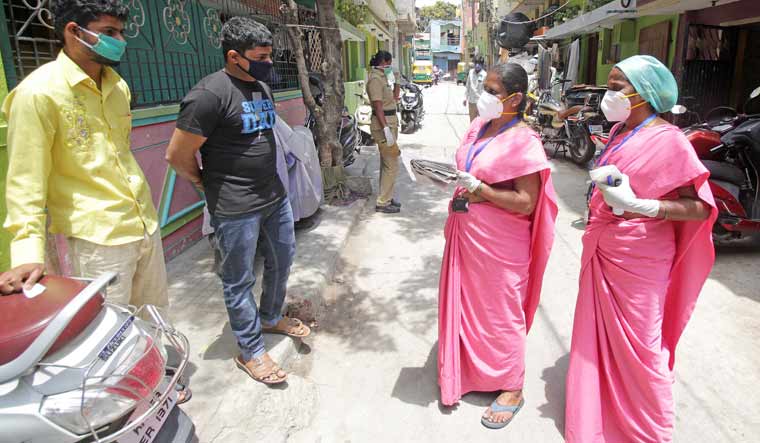On 22nd March, as per the government’s request every Indian expressed their gratitude towards the health workers dealing pandemic on the frontlines. ASHA (Accredited Social Health Activist) workers are one among them placed at the first line of defence to combat COVID-19 by the government. But what the government missed is to resolve the problems faced by ASHAs. Once again, Coronavirus has grabbed our attention to this secluded section of ASHA workers and given us the timely reminder of pay disparities and gender based segregation of professions.
When a pink sari woman walks door to door carrying loads of documents trying to keep government machinery proactive, who knows what kind of baggage she hauls in her own life. She validates the presence of others, but she is aloof of the healthcare management and government.
On an average, the ASHA workers receive honorarium of rupees 2000-3000 per month and in the Coronavirus pandemic period, the government is providing additional 1000/-. The value of an ASHA worker’s life is rupees 33 per day. Their daily target is to survey 25 to 30 houses which means they are paid 0.90 paisa per house. In Maharashtra, more than 70,000 ASHA workers are working head to toe to manage coronavirus in both urban and rural India.
On an average, the ASHA workers receive honorarium of INR 2000-3000 per month and in the Coronavirus pandemic period, the government is providing additional INR 1000. The value of an ASHA worker’s life is INR 33 per day.
“Who wants to go out? But the virus of hunger is bigger than Coronavirus. My life’s value is 30 Rs per day but I have no option, my only urge is to get a little more money,” says Nirmala Mane, an ASHA worker. Nirmala residing in Kashil, Satara has to go to work, as her husband cannot work. She is taking a deadly risk to feed her family by interacting with dozens of people. However, what she earns is peanuts. There are many like Nirmala who step out at 9 am and start moving from door to door to count, counsel and quarantine people.
ASHA workers are as important as any other healthcare worker. They are not treated as permanent workers because they are considered more as activists, than employees. They hold the key to the age old problem of India: documentation. Right from the pregnancy of a woman, child birth to the death of the person, every detail is documented by them. In this period, they stand out as more important as they are the interface between every individual of the community and health care management. The surveys are carried by them in both rural and urban areas. They are risking their life and working 6 to 7 hours through hot summer asking details from home to home.
Ujjawala, CITU trade union president from Nanded says, “MPW, medical officers are paid 50,000/- but ASHAs are not even 10% worth of it.” According to her, no medical officer reaches ground level, all actions are taken on the basis of ASHAs report and submitted further. An average ASHA worker has to go through two problems; one with financial issues and second with her safety. Sadly, the government came to rescue for none.
The government has declared 50 lakh insurance for health care workers but ASHAs are asking for an increase in pay scale. According to Ujjawala, ‘what money is better after death when survival is in trouble?‘ They are demanding rupees 500 per day for their work in the pandemic period and demanding safety gears. The 50 lakh insurance has brought no happiness to ASHA workers. Before Coronavirus, ASHA workers had insurance of 2 lakhs rupees that has no separate provision in government books. 12 rupees and 330 rupees are deducted from the salary and that is how it amounts to the total insurance. The question that lingers on is, whether the package of government turns out as a real relief for them.
ASHA workers hold the key to the age old problem of India: documentation.
The work of ASHA has been rewarding since rural cases are less positive comparatively to urban. Testing is something in which India stands far away and in such situations, surveys are proved to be one of the best options to reach out to every lane and every house of India.
As per Dr. Amol from Sangli, Maharashtra, the mass testing is difficult but surveys can be an effective way to identify people and categories accordingly, so that testing can be narrowed further. That is what ASHA workers are doing. The government might have faced difficulty in carrying on further activities if the surveys were not taking place.
Also read: The Anganwadi And ASHA Workers’ Fight Against Malnutrition
Safety on Stake, Humiliation at Par
Being an integral part of the coronavirus prevention chain, they are the first one in contact with people. ASHA workers are yet not provided with personal protective equipment or safety gears. Their safety totally depends upon a bottle of sanitizer and 6 hours disposal mask. It has been reported ASHA workers are asked to wear a piece of dupatta or a corner of sari for safety. How, with such lackadaisical work ethics, will they be able to protect themselves? One of the reports from Satara, Maharashtra has highlighted how demanding safety gears workers are getting advice to resign from the health department.
Along with safety, the humiliation is another part of the starter packs for ASHA workers. The verbal humiliation is on the peak of it. On one hand, the government is turning their back on them and on other hand, common people are harassing them. Recently, a few days back in Devani Taluka, Latur, an on duty ASHA worker Suksham Makane was hit by a truncheon leaving her injured by natives. Several cases are reported all over Maharashtra, yet no measures are being implemented for their security.
Rajendra Sathe, chief of ASHA Workers Union from Nagpur said, ‘Municipal Corporation worker, who is responsible for supervising ASHAs drops them on location and later picks them. No other officer or police accompanied them in areas where ASHAs have been insulted and harassed several times’.
ASHA workers are yet not provided with personal protective equipment or safety gears.
Old Wounds
There are two reasons for such inhuman behavior. Firstly, it points out the lack of awareness. The ASHA workers’s work include stamping people and quarantining them. This has created panic among people. Secondly, the horror also comes from the previous dead, the NRC and CAA issue. As per Rajendra Sathe, the Muslim areas are not allowing ASHAs to do their work as they think, through ASHA the government is trying to extract their details and once this is over, this will be used against them. The wounds of CAA and NRC are so deep in people that its after effects are visible on workers. In rural areas, for every 1000 people, 1 ASHA worker is on duty and in urban areas, it is 15000:1. It is difficult for them to explain each of them the reality of the situation, as people don’t allow them to even stand on doors.
Also read: Female ASHA Workers Rally Demanding Better Wages And Working Conditions
CITU has sent several letters to the government officials but so far no response has been availed. Talking to DCM, the Chief Program officer Karan Jagtap, he said, ‘Rural health mission is incomplete without ASHA worker. We are trying to communicate with decision makers and placing several issues. So far, lots of changes have occurred, soon such problems will also be resolved. The primary problem is the nature of employment. These workers are working as activists rather as an employee’.
Snehal is a writer just trying to explore and unleash stories from the world. You can find her on LinkedIn, Instagram and Twitter.
Featured Image Source: The Week



